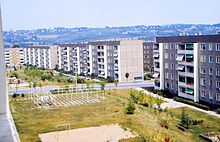Zauckerode
|
Zauckerode
Large district town of Freital
Coordinates: 51 ° 1 ′ 5 ″ N , 13 ° 38 ′ 20 ″ E
|
|
|---|---|
| Height : | 186 m |
| Area : | 1.52 km² |
| Residents : | 4785 (Dec. 31, 2017) |
| Population density : | 3,148 inhabitants / km² |
| Incorporation : | October 1, 1922 |
| Postal code : | 01705 |
| Area code : | 0351 |
|
Location of Zauckerode in Freital
|
|
Zauckerode (also outdated Zaukeroda ) is a district of the Saxon large district town Freital in the district of Saxon Switzerland-Eastern Ore Mountains .
geography
Neighboring places
| Wurgwitz | Pesterwitz | Pesterwitz |
| Wurgwitz |

|
Potschappel |
| Saalhausen | Döhlen | Döhlen |
history


The place Zauckerode, first mentioned in 1228 as a manor house , was off the main routes of the Plauen reason . The family named (Arnoldus de Zukerade), which is unique in an episcopal Meissnian document, could go back to the Lords of Döhlen (Arnoldus de Dolen 1206). It was made a manor in the 17th century. In addition to a grinding mill on the Wiederitz , there was also a manor brewery , whose wheat beers were very popular even at the court of Augustus the Strong .
In the 18th century, the von Polenz family began to mine coal on a large scale for the first time . However, neither the von Polenz family nor the successors of Schönberg succeeded in doing profitable mining. At the turn of the 19th century, coal mining almost came to a standstill to the left of the Weißeritz . On behalf of the Freiberg Mining Authority, state-subsidized coal has been mined in nearby Niederhermsdorf since 1789 for the iron and steel works around Freiberg . When, after a change of ownership and a more detailed exploration of the deposits, this mine was bought by the Saxon tax authorities in 1799, the foundation stone of what would later become the Royal Zauckerode Coal Works was laid under Carl Wilhelm von Oppel and Ernst Friedrich Wilhelm Lindig . In 1806, the manors Zauckerode and Döhlen, along with all the mining fields, were sold to the Saxon state. This was the first time a contiguous mine field was created in the Döhlen basin , which enabled profitable mining.
At a prominent location near the Oppelschacht, a headframe relocated from the former Dresden-Gittersee shaft point is reminiscent of the coal mining industry . The former coal works of the Oppelschachtes in Zauckerode now serves as a domicile for the Freital City Library and two associations. After hard coal mining came to an end in 1959 on Freitaler Stadtflur and in 1989 on the entire deposit, Wismut GmbH rehabilitated the Tiefen Elbstolln between 1993 and 2001 . The tunnel, completed in 1837, still drains the old mining areas of the Döhlen basin to the left of the Weißeritz. Around 180 years after its excavation , the Elbstolln still plays an important role in the hydrological system of the city of Freital, to which Zauckerode has belonged since October 1, 1922.
The technical development, starting with the invention of the coal washing machine ( Ernst Friedrich Wilhelm Lindig ) in 1810, the first steam engine in the Saxon mining industry in 1820, to the world's first electric locomotive in continuous use ( Dorothea mine locomotive , Oppelschacht) in 1882, made the small town of Zauckerode and his coal plant is known far beyond the Saxon borders. From 1876 to 1878 Otto Lilienthal developed and tested his cutting machine in the Royal Coal Works and also got to know his future wife Agnes Fischer, the daughter of the Zauckeroder Obersteigers Hermann Fischer. Original photos of the Oppelschacht and the coal mining in the late 19th century from the photo book The Coal Miner in His Profession (Heinrich Börner, 1894) are available online.
The Bombastus-Werke , founded in Potschappel in 1904, have had their headquarters, production facilities and cultivation areas in Zauckerode since 1906. During the past GDR era, the factory was the sole processor of self-cultivated sage , and tea, cosmetics and health care products are still produced today.
Zauckerode became important in terms of urban development in the years after 1970. On an area of 38 hectares , almost 2,500 apartments were built in the prefabricated building standard between 1974 and 1984 and have been renovated since 1992.
traffic
From 1886 to 1972 Zauckerode had a train station on the Freital-Potschappel-Nossen narrow-gauge railway . In addition, the Niederhermsdorfer coal branch line to the Oppelschacht existed since 1856 , which was planned by Guido Brescius as a branch line of the Albertsbahn Dresden – Tharandt .
Zauckerode is located directly on State Road 36 , via which one can reach the federal motorway 17 via the Dresden-Gorbitz junction . The nearest airport is Dresden Airport . Zauckerode is located in the Freital tariff zone of the Upper Elbe public transport network and is therefore connected to local public transport . The regional traffic Saxon Switzerland-Eastern Ore Mountains serves eight bus stops in the local area.
literature
- Cornelius Gurlitt : Zauckerode. In: Descriptive representation of the older architectural and art monuments of the Kingdom of Saxony. 24. Issue: Amtshauptmannschaft Dresden-Altstadt (Land) . CC Meinhold, Dresden 1904, p. 136.
Web links
- Zauckerode in the Digital Historical Directory of Saxony
- History of Zauckerode www.freital.de
Individual evidence
- ↑ Update of the Integrated Urban Development Concept (INSEK). (PDF; 120 MB) Urban development Freital 2030plus. Stadtverwaltung Freital, STEG Stadtentwicklung GmbH, January 2020, p. 92 , accessed on July 13, 2020 .
- ↑ Seal from 1900 with the imprint "Zaukeroda"
- ^ Zauckerode (incorporated in 1922). In: freital.de. Retrieved November 9, 2018 .
- ↑ The coal miner in his profession (1894)



